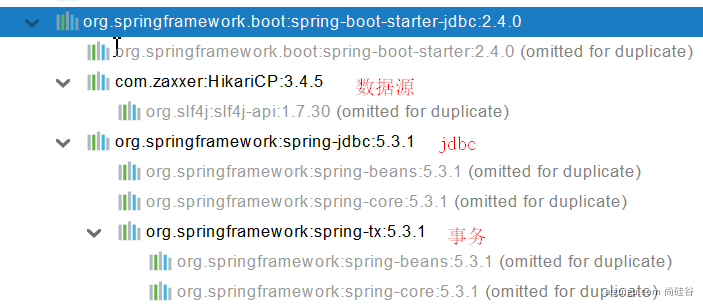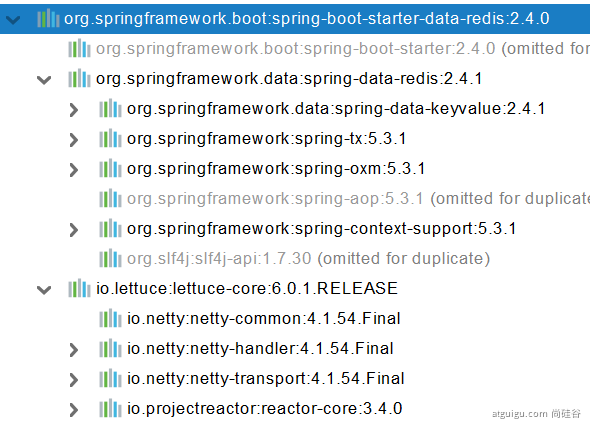 springboot数据访问
springboot数据访问
# 1、SQL
# 1、数据源的自动配置-HikariDataSource
# 1、导入JDBC场景
<dependency>
<groupId>org.springframework.boot</groupId>
<artifactId>spring-boot-starter-data-jdbc</artifactId>
</dependency>
2
3
4
5

# 数据库驱动?
为什么导入JDBC场景,官方不导入驱动?官方不知道我们接下要操作什么数据库。
数据库版本和驱动版本对应
默认版本:<mysql.version>8.0.22</mysql.version>
<dependency>
<groupId>mysql</groupId>
<artifactId>mysql-connector-java</artifactId>
<!-- <version>5.1.49</version>-->
</dependency>
想要修改版本
1、直接依赖引入具体版本(maven的就近依赖原则)
2、重新声明版本(maven的属性的就近优先原则)
<properties>
<java.version>1.8</java.version>
<mysql.version>5.1.49</mysql.version>
</properties>
2
3
4
5
6
7
8
9
10
11
12
13
14
# 2、分析自动配置
# 1、自动配置的类
DataSourceAutoConfiguration : 数据源的自动配置
- 修改数据源相关的配置:spring.datasource
- 数据库连接池的配置,是自己容器中没有DataSource才自动配置的
- 底层配置好的连接池是:HikariDataSource
@Configuration(proxyBeanMethods = false)
@Conditional(PooledDataSourceCondition.class)
@ConditionalOnMissingBean({ DataSource.class, XADataSource.class })
@Import({ DataSourceConfiguration.Hikari.class, DataSourceConfiguration.Tomcat.class,
DataSourceConfiguration.Dbcp2.class, DataSourceConfiguration.OracleUcp.class,
DataSourceConfiguration.Generic.class, DataSourceJmxConfiguration.class })
protected static class PooledDataSourceConfiguration
2
3
4
5
6
7
DataSourceTransactionManagerAutoConfiguration: 事务管理器的自动配置
JdbcTemplateAutoConfiguration: JdbcTemplate的自动配置,可以来对数据库进行crud
- 可以修改这个配置项@ConfigurationProperties(prefix = "spring.jdbc") 来修改JdbcTemplate
- @Bean@Primary JdbcTemplate;容器中有这个组件
JndiDataSourceAutoConfiguration: jndi的自动配置
XADataSourceAutoConfiguration: 分布式事务相关的
# 3、修改配置项
spring:
datasource:
url: jdbc:mysql://localhost:3306/db_account
username: root
password: 123456
driver-class-name: com.mysql.cj.jdbc.Driver
2
3
4
5
6
# 4、测试
@Slf4j
@SpringBootTest
class Boot05WebAdminApplicationTests {
@Autowired
JdbcTemplate jdbcTemplate;
@Test
void contextLoads() {
// jdbcTemplate.queryForObject("select * from account_tbl")
// jdbcTemplate.queryForList("select * from account_tbl",)
Long aLong = jdbcTemplate.queryForObject("select count(*) from account_tbl", Long.class);
log.info("记录总数:{}",aLong);
}
}
2
3
4
5
6
7
8
9
10
11
12
13
14
15
16
17
18
# 2、使用Druid数据源
# 1、druid官方github地址
https://github.com/alibaba/druid
# 整合第三方技术的两种方式
- 自定义
- 找starter
# 2、自定义方式
# 1、创建数据源
<dependency>
<groupId>com.alibaba</groupId>
<artifactId>druid</artifactId>
<version>1.1.17</version>
</dependency>
<bean id="dataSource" class="com.alibaba.druid.pool.DruidDataSource"
destroy-method="close">
<property name="url" value="${jdbc.url}" />
<property name="username" value="${jdbc.username}" />
<property name="password" value="${jdbc.password}" />
<property name="maxActive" value="20" />
<property name="initialSize" value="1" />
<property name="maxWait" value="60000" />
<property name="minIdle" value="1" />
<property name="timeBetweenEvictionRunsMillis" value="60000" />
<property name="minEvictableIdleTimeMillis" value="300000" />
<property name="testWhileIdle" value="true" />
<property name="testOnBorrow" value="false" />
<property name="testOnReturn" value="false" />
<property name="poolPreparedStatements" value="true" />
<property name="maxOpenPreparedStatements" value="20" />
2
3
4
5
6
7
8
9
10
11
12
13
14
15
16
17
18
19
20
21
22
# 2、StatViewServlet
StatViewServlet的用途包括:
- 提供监控信息展示的html页面
- 提供监控信息的JSON API
<servlet>
<servlet-name>DruidStatView</servlet-name>
<servlet-class>com.alibaba.druid.support.http.StatViewServlet</servlet-class>
</servlet>
<servlet-mapping>
<servlet-name>DruidStatView</servlet-name>
<url-pattern>/druid/*</url-pattern>
</servlet-mapping>
2
3
4
5
6
7
8
# 3、StatFilter
用于统计监控信息;如SQL监控、URI监控
需要给数据源中配置如下属性;可以允许多个filter,多个用,分割;如:
<property name="filters" value="stat,slf4j" />
2
3
系统中所有filter:
| 别名 | Filter类名 |
|---|---|
| default | com.alibaba.druid.filter.stat.StatFilter |
| stat | com.alibaba.druid.filter.stat.StatFilter |
| mergeStat | com.alibaba.druid.filter.stat.MergeStatFilter |
| encoding | com.alibaba.druid.filter.encoding.EncodingConvertFilter |
| log4j | com.alibaba.druid.filter.logging.Log4jFilter |
| log4j2 | com.alibaba.druid.filter.logging.Log4j2Filter |
| slf4j | com.alibaba.druid.filter.logging.Slf4jLogFilter |
| commonlogging | com.alibaba.druid.filter.logging.CommonsLogFilter |
慢SQL记录配置
<bean id="stat-filter" class="com.alibaba.druid.filter.stat.StatFilter">
<property name="slowSqlMillis" value="10000" />
<property name="logSlowSql" value="true" />
</bean>
使用 slowSqlMillis 定义慢SQL的时长
2
3
4
5
6
# 3、使用官方starter方式
# 1、引入druid-starter
<dependency>
<groupId>com.alibaba</groupId>
<artifactId>druid-spring-boot-starter</artifactId>
<version>1.1.17</version>
</dependency>
2
3
4
5
# 2、分析自动配置
扩展配置项 spring.datasource.druid
DruidSpringAopConfiguration.class, 监控SpringBean的;配置项:spring.datasource.druid.aop-patterns
DruidStatViewServletConfiguration.class, 监控页的配置:spring.datasource.druid.stat-view-servlet;默认开启
DruidWebStatFilterConfiguration.class, web监控配置;spring.datasource.druid.web-stat-filter;默认开启
DruidFilterConfiguration.class}) 所有Druid自己filter的配置
private static final String FILTER_STAT_PREFIX = "spring.datasource.druid.filter.stat";
private static final String FILTER_CONFIG_PREFIX = "spring.datasource.druid.filter.config";
private static final String FILTER_ENCODING_PREFIX = "spring.datasource.druid.filter.encoding";
private static final String FILTER_SLF4J_PREFIX = "spring.datasource.druid.filter.slf4j";
private static final String FILTER_LOG4J_PREFIX = "spring.datasource.druid.filter.log4j";
private static final String FILTER_LOG4J2_PREFIX = "spring.datasource.druid.filter.log4j2";
private static final String FILTER_COMMONS_LOG_PREFIX = "spring.datasource.druid.filter.commons-log";
private static final String FILTER_WALL_PREFIX = "spring.datasource.druid.filter.wall";
2
3
4
5
6
7
8
# 3、配置示例
spring:
datasource:
url: jdbc:mysql://localhost:3306/db_account
username: root
password: 123456
driver-class-name: com.mysql.jdbc.Driver
druid:
aop-patterns: com.atguigu.admin.* #监控SpringBean
filters: stat,wall # 底层开启功能,stat(sql监控),wall(防火墙)
stat-view-servlet: # 配置监控页功能
enabled: true
login-username: admin
login-password: admin
resetEnable: false
web-stat-filter: # 监控web
enabled: true
urlPattern: /*
exclusions: '*.js,*.gif,*.jpg,*.png,*.css,*.ico,/druid/*'
filter:
stat: # 对上面filters里面的stat的详细配置
slow-sql-millis: 1000
logSlowSql: true
enabled: true
wall:
enabled: true
config:
drop-table-allow: false
2
3
4
5
6
7
8
9
10
11
12
13
14
15
16
17
18
19
20
21
22
23
24
25
26
27
28
29
30
31
32
SpringBoot配置示例
https://github.com/alibaba/druid/tree/master/druid-spring-boot-starter
# 3、整合MyBatis操作
https://github.com/mybatis
starter
SpringBoot官方的Starter:spring-boot-starter-*
第三方的: *-spring-boot-starter
<dependency>
<groupId>org.mybatis.spring.boot</groupId>
<artifactId>mybatis-spring-boot-starter</artifactId>
<version>2.1.4</version>
</dependency>
2
3
4
5

# 1、配置模式
全局配置文件
SqlSessionFactory: 自动配置好了
SqlSession:自动配置了 SqlSessionTemplate 组合了SqlSession
@Import(AutoConfiguredMapperScannerRegistrar.class);
Mapper: 只要我们写的操作MyBatis的接口标准了 @Mapper 就会被自动扫描进来
@EnableConfigurationProperties(MybatisProperties.class) : MyBatis配置项绑定类。
@AutoConfigureAfter({ DataSourceAutoConfiguration.class, MybatisLanguageDriverAutoConfiguration.class })
public class MybatisAutoConfiguration{}
@ConfigurationProperties(prefix = "mybatis")
public class MybatisProperties
2
3
4
5
6
可以修改配置文件中 mybatis 开始的所有;
# 配置mybatis规则
mybatis:
config-location: classpath:mybatis/mybatis-config.xml #全局配置文件位置
mapper-locations: classpath:mybatis/mapper/*.xml #sql映射文件位置
Mapper接口--->绑定Xml
<?xml version="1.0" encoding="UTF-8" ?>
<!DOCTYPE mapper
PUBLIC "-//mybatis.org//DTD Mapper 3.0//EN"
"http://mybatis.org/dtd/mybatis-3-mapper.dtd">
<mapper namespace="com.atguigu.admin.mapper.AccountMapper">
<!-- public Account getAcct(Long id); -->
<select id="getAcct" resultType="com.atguigu.admin.bean.Account">
select * from account_tbl where id=#{id}
</select>
</mapper>
2
3
4
5
6
7
8
9
10
11
12
13
14
15
16
配置 private Configuration configuration; mybatis.configuration下面的所有,就是相当于改mybatis全局配置文件中的值
# 配置mybatis规则
mybatis:
# config-location: classpath:mybatis/mybatis-config.xml
mapper-locations: classpath:mybatis/mapper/**/*.xml
configuration:
map-underscore-to-camel-case: true
可以不写全局;配置文件,所有全局配置文件的配置都放在configuration配置项中即可
2
3
4
5
6
7
8
导入mybatis官方starter
编写mapper接口。标准@Mapper注解
编写sql映射文件并绑定mapper接口
在application.yaml中指定Mapper配置文件的位置,以及指定全局配置文件的信息 (建议;配置在mybatis.configuration)
# 2、注解模式
@Mapper
public interface CityMapper {
@Select("select * from city where id=#{id}")
public City getById(Long id);
@Insert("insert into city(`name`,`state`,`country`) values(#{name},#{state},#{country})")
@Options(useGeneratedKeys = true,keyProperty = "id")
public void insert(City city);
}
2
3
4
5
6
7
8
9
10
11
# 3、混合模式
@Mapper
public interface CityMapper {
@Select("select * from city where id=#{id}")
public City getById(Long id);
public void insert(City city);
}
2
3
4
5
6
7
8
9
最佳实战:
1、引入mybatis-starter
2、配置application.yaml中,指定mapper-location位置即可
3、编写Mapper接口并标注@Mapper注解; 或者@MapperScan("com.zxp.admin.mapper") 简化,其他的接口就可以不用标注@Mapper注解
简单方法直接注解方式
复杂方法编写mapper.xml进行绑定映射
# 4、整合 MyBatis-Plus 完成CRUD
# 1、什么是MyBatis-Plus
MyBatis-Plus (opens new window)(简称 MP)是一个 MyBatis (opens new window) 的增强工具,在 MyBatis 的基础上只做增强不做改变,为简化开发、提高效率而生。
mybatis plus 官网 (opens new window)
建议安装 MybatisX 插件
# 2、整合MyBatis-Plus
<dependency>
<groupId>com.baomidou</groupId>
<artifactId>mybatis-plus-boot-starter</artifactId>
<version>3.4.1</version>
</dependency>
2
3
4
5
自动配置
MybatisPlusAutoConfiguration 配置类,MybatisPlusProperties 配置项绑定。mybatis-plus:xxx 就是对****mybatis-plus的定制
SqlSessionFactory 自动配置好。底层是容器中默认的数据源
**mapperLocations 自动配置好的。有默认值。*classpath*:/mapper/*/*.xml;任意包的类路径下的所有mapper文件夹下任意路径下的所有xml都是sql映射文件。 建议以后sql映射文件,放在 mapper下
容器中也自动配置好了 SqlSessionTemplate
@Mapper 标注的接口也会被自动扫描;建议直接 @MapperScan("com.atguigu.admin.mapper") 批量扫描就行
优点:
- 只需要我们的Mapper继承 BaseMapper 就可以拥有crud能力
# 3、CRUD功能
@GetMapping("/user/delete/{id}")
public String deleteUser(@PathVariable("id") Long id,
@RequestParam(value = "pn",defaultValue = "1")Integer pn,
RedirectAttributes ra){
userService.removeById(id);
ra.addAttribute("pn",pn);
return "redirect:/dynamic_table";
}
@GetMapping("/dynamic_table")
public String dynamic_table(@RequestParam(value="pn",defaultValue = "1") Integer pn,Model model){
//表格内容的遍历
// response.sendError
// List<User> users = Arrays.asList(new User("zhangsan", "123456"),
// new User("lisi", "123444"),
// new User("haha", "aaaaa"),
// new User("hehe ", "aaddd"));
// model.addAttribute("users",users);
//
// if(users.size()>3){
// throw new UserTooManyException();
// }
//从数据库中查出user表中的用户进行展示
//构造分页参数
Page<User> page = new Page<>(pn, 2);
//调用page进行分页
Page<User> userPage = userService.page(page, null);
// userPage.getRecords()
// userPage.getCurrent()
// userPage.getPages()
model.addAttribute("users",userPage);
return "table/dynamic_table";
}
2
3
4
5
6
7
8
9
10
11
12
13
14
15
16
17
18
19
20
21
22
23
24
25
26
27
28
29
30
31
32
33
34
35
36
37
38
39
40
41
42
@Service
public class UserServiceImpl extends ServiceImpl<UserMapper,User> implements UserService {
}
public interface UserService extends IService<User> {
}
2
3
4
5
6
7
8
9
# 2、JPA
# 3、NoSQL
Redis 是一个开源(BSD许可)的,内存中的数据结构存储系统,它可以用作数据库、缓存和消息中间件。 它支持多种类型的数据结构,如 字符串(strings) (opens new window), 散列(hashes) (opens new window), 列表(lists) (opens new window), 集合(sets) (opens new window), 有序集合(sorted sets) (opens new window) 与范围查询, bitmaps (opens new window), hyperloglogs (opens new window) 和 地理空间(geospatial) (opens new window) 索引半径查询。 Redis 内置了 复制(replication) (opens new window),LUA脚本(Lua scripting) (opens new window), LRU驱动事件(LRU eviction) (opens new window),事务(transactions) (opens new window) 和不同级别的 磁盘持久化(persistence) (opens new window), 并通过 Redis哨兵(Sentinel) (opens new window)和自动 分区(Cluster) (opens new window)提供高可用性(high availability)。
# 1、Redis自动配置
<dependency>
<groupId>org.springframework.boot</groupId>
<artifactId>spring-boot-starter-data-redis</artifactId>
</dependency>
2
3
4

# 自动配置:
RedisAutoConfiguration自动配置类,见源码。RedisProperties 属性类 --> spring.redis.xxx是对redis的配置连接工厂是准备好的。LettuceConnectionConfiguration、JedisConnectionConfiguration
自动注入了RedisTemplate<Object, Object> : xxxTemplate;
自动注入了StringRedisTemplate;k:v都是String
key:value
底层只要我们使用 **StringRedisTemplate、**RedisTemplate就可以操作redis
@Configuration(proxyBeanMethods = false)
@ConditionalOnClass(RedisOperations.class)
@EnableConfigurationProperties(RedisProperties.class)
@Import({ LettuceConnectionConfiguration.class, JedisConnectionConfiguration.class })
public class RedisAutoConfiguration {
@Bean
@ConditionalOnMissingBean(name = "redisTemplate")
@ConditionalOnSingleCandidate(RedisConnectionFactory.class)
public RedisTemplate<Object, Object> redisTemplate(RedisConnectionFactory redisConnectionFactory) {
RedisTemplate<Object, Object> template = new RedisTemplate<>();
template.setConnectionFactory(redisConnectionFactory);
return template;
}
@Bean
@ConditionalOnMissingBean
@ConditionalOnSingleCandidate(RedisConnectionFactory.class)
public StringRedisTemplate stringRedisTemplate(RedisConnectionFactory redisConnectionFactory) {
StringRedisTemplate template = new StringRedisTemplate();
template.setConnectionFactory(redisConnectionFactory);
return template;
}
}
2
3
4
5
6
7
8
9
10
11
12
13
14
15
16
17
18
19
20
21
22
23
24
25
# redis环境搭建
1、阿里云按量付费redis。经典网络
2、申请redis的公网连接地址
3、修改白名单 允许0.0.0.0/0 访问
# 2、RedisTemplate与Lettuce
@Test
void testRedis(){
ValueOperations<String, String> operations = redisTemplate.opsForValue();
operations.set("hello","world");
String hello = operations.get("hello");
System.out.println(hello);
}
2
3
4
5
6
7
8
9
# 3、切换至jedis
<dependency>
<groupId>org.springframework.boot</groupId>
<artifactId>spring-boot-starter-data-redis</artifactId>
</dependency>
<!-- 导入jedis-->
<dependency>
<groupId>redis.clients</groupId>
<artifactId>jedis</artifactId>
</dependency>
spring:
redis:
host: r-bp1nc7reqesxisgxpipd.redis.rds.aliyuncs.com
port: 6379
password: lfy:Lfy123456
client-type: jedis
jedis:
pool:
max-active: 10
2
3
4
5
6
7
8
9
10
11
12
13
14
15
16
17
18
19
# 4、修改RedisTemplate的序列化策略
springboot中提供了StringRedisTemplate和RedisTemplate两种序列化类,它们都只能读自己存的数据,即数据互不相通。
# StringRedisTemplate和RedisTemplate主要区别
1、采用的序列化策略不同
StringRedisTemplate采用的是String的序列化策略;RedisTemplate默认采用的是jdk的序列化策略
2、存的数据形式不同
StringRedisTemplate存的是字符串;RedisTemplate存的是字节数组,在redis-cli中看好像乱码
3、使用范围不同
StringRedisTemplate只能处理字符串类型的数据,如果存取复杂的对象,又不想做额外的处理,最好用RedisTemplate
4、RedisTemplate可以根据需要设置序列化策略
默认的是jdk的JdkSerializationRedisSerializer,常用的还有Jackson2JsonRedisSerializer、GenericJackson2JsonRedisSerializer等
# 关于Jdk与Jackson2序列化策略的说明
1、使用jdk序列化对象必须实现序列化接口;使用Jackson2无需实现序列化接口(内部实现了)
2、jdk序列化到redis中,key显示类似于乱码,Jackson2的key显示设置的值(创建RedisTemplate时设置了key的序列化)
3、jdk的反序列化很好,直接转化为对象,Jackson2的读出来是Map,需要将Map转为json串,再转化为类对象
4、如果使用Jackson2读出来直接转化为类对象,需要创建RedisTemplate时重新设置(后面补充上)
5、使用GenericJackson2JsonRedisSerializer序列化时,会保存序列化的对象的包名和类名,反序列化时以这个作为标示就可以反序列化成指定的对象。
/**
* 参考: org.springframework.boot.autoconfigure.jackson.JacksonAutoConfiguration
* @author: shollin
* @date: 2021/6/27/027 18:30
*/
@Configuration
public class JacksonConfig {
/**
* 修复 hibernateLazyInitializer序列化值有空的问题、 jdk8时间日期序列化、long 问题
* @return
*/
@Bean
public ObjectMapper objectMapper() {
JavaTimeModule javaTimeModule = new JavaTimeModule();
/** 序列化配置,针对java8 时间 **/
javaTimeModule.addSerializer(LocalDateTime.class, new LocalDateTimeSerializer(DateTimeFormatter.ofPattern("yyyy-MM-dd HH:mm:ss")));
javaTimeModule.addSerializer(LocalDate.class, new LocalDateSerializer(DateTimeFormatter.ofPattern("yyyy-MM-dd")));
javaTimeModule.addSerializer(LocalTime.class, new LocalTimeSerializer(DateTimeFormatter.ofPattern("HH:mm:ss")));
/** 反序列化配置,针对java8 时间 **/
javaTimeModule.addDeserializer(LocalDateTime.class, new LocalDateTimeDeserializer(DateTimeFormatter.ofPattern("yyyy-MM-dd HH:mm:ss")));
javaTimeModule.addDeserializer(LocalDate.class, new LocalDateDeserializer(DateTimeFormatter.ofPattern("yyyy-MM-dd")));
javaTimeModule.addDeserializer(LocalTime.class, new LocalTimeDeserializer(DateTimeFormatter.ofPattern("HH:mm:ss")));
/** Long转String类型 **/
SimpleModule simpleModule = new SimpleModule();
simpleModule.addSerializer(Long.class, ToStringSerializer.instance);
simpleModule.addSerializer(Long.TYPE, ToStringSerializer.instance);
return Jackson2ObjectMapperBuilder.json().createXmlMapper(false).modules(javaTimeModule,simpleModule).build()
.disable(SerializationFeature.FAIL_ON_EMPTY_BEANS);
}
}
2
3
4
5
6
7
8
9
10
11
12
13
14
15
16
17
18
19
20
21
22
23
24
25
26
27
28
29
30
31
32
33
34
35
36
37
/**
* 参考 org.springframework.boot.autoconfigure.data.redis.RedisAutoConfiguration
* @author: shollin
* @date: 2021/6/29/029 8:04
*/
@Configuration
public class RedisConfig {
/**
* value 值 序列化
* @return RedisSerializer
*/
@Bean
public RedisSerializer<Object> redisSerializer(ObjectProvider<ObjectMapper> objectProvider) {
// jackson findAndRegisterModules,use copy
ObjectMapper objectMapper = objectProvider.getIfAvailable(ObjectMapper::new).copy();
// findAndRegisterModules
objectMapper.findAndRegisterModules();
// class type info to json
GenericJackson2JsonRedisSerializer.registerNullValueSerializer(objectMapper, null);
objectMapper.activateDefaultTyping(objectMapper.getPolymorphicTypeValidator(), DefaultTyping.NON_FINAL, As.PROPERTY);
return new GenericJackson2JsonRedisSerializer(objectMapper);
}
@Bean(name = "redisTemplate")
public RedisTemplate<Object, Object> redisTemplate(RedisConnectionFactory redisConnectionFactory,RedisSerializer<Object> redisSerializer) {
RedisTemplate<Object, Object> template = new RedisTemplate<>();
// 默认的jdk序列化器,源码中要求bean实现Serializer接口
//JdkSerializationRedisSerializer jdkSerializationRedisSerializer = new JdkSerializationRedisSerializer();
//使用fastjson序列化,它里面new ObjectMapper(); 所以需要自己参考自定义序列化器
//Jackson2JsonRedisSerializer<Object> fastJsonRedisSerializer = new Jackson2JsonRedisSerializer<Object>(Object.class);
//value的序列化采用fastJsonRedisSerializer
template.setValueSerializer(redisSerializer);
template.setHashValueSerializer(redisSerializer);
//key的序列化采用StringRedisSerializer, key必须为String类型,不然会报错
template.setKeySerializer(new StringRedisSerializer());
template.setHashKeySerializer(new StringRedisSerializer());
template.setConnectionFactory(redisConnectionFactory);
return template;
}
}
2
3
4
5
6
7
8
9
10
11
12
13
14
15
16
17
18
19
20
21
22
23
24
25
26
27
28
29
30
31
32
33
34
35
36
37
38
39
40
41
42
43
44
45
46
47
48
49
要注意的是,key采用的是StringRedisSerializer,则设置key的时候,必须是String类型,不然会报类型转换错误

/**
* 将redis key序列化为字符串
*
* <p>
* spring cache中的简单基本类型直接使用 StringRedisSerializer 会有问题
* </p>
*
* @author L.cm
*/
public class RedisKeySerializer implements RedisSerializer<Object> {
private final Charset charset;
private final ConversionService converter;
public RedisKeySerializer() {
this(StandardCharsets.UTF_8);
}
public RedisKeySerializer(Charset charset) {
Objects.requireNonNull(charset, "Charset must not be null");
this.charset = charset;
this.converter = DefaultConversionService.getSharedInstance();
}
@Override
public Object deserialize(byte[] bytes) {
// redis keys 会用到反序列化
if (bytes == null) {
return null;
}
return new String(bytes, charset);
}
@Override
@Nullable
public byte[] serialize(Object object) {
Objects.requireNonNull(object, "redis key is null");
String key;
if (object instanceof SimpleKey) {
key = "";
} else if (object instanceof String) {
key = (String) object;
} else {
key = converter.convert(object, String.class);
}
return key.getBytes(this.charset);
}
}
2
3
4
5
6
7
8
9
10
11
12
13
14
15
16
17
18
19
20
21
22
23
24
25
26
27
28
29
30
31
32
33
34
35
36
37
38
39
40
41
42
43
44
45
46
47
48
redis的java客户端StringRedisTemplate、RedisTemplate的用法及区别 - 明月之诗 - 博客园 (cnblogs.com) (opens new window)
参考文档:
